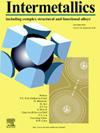Twining evolution and dynamic recrystallization mechanism in GH4706 alloy during hot deformation
IF 4.3
2区 材料科学
Q2 CHEMISTRY, PHYSICAL
引用次数: 0
Abstract
The dynamic recrystallization (DRX) mechanisms and microstructural evolution of the GH4706 alloy are investigated through isothermal constant strain rate hot compression experiments. The experiments are conducted under different deformation parameters. The effects of different deformation parameters on the substructure, grain boundary (GB), misorientation and twinning are systematically studied. The results indicate that T (Temperature), (strain rate), and ε (strain) significantly influence the DRX mechanism and microstructural evolution of GH4706 alloy. As ε increases, Σ3 twin boundaries deviate from their specific orientation. However, new twin structures are formed during the recrystallized grain growth process, with high T and low being more conducive to twin formation. Additionally, discontinuous dynamic recrystallization (DDRX) behavior is identified across all deformation parameters, establishing DDRX as the prime process of DRX in the GH4706 alloy. Continuous dynamic recrystallization (CDRX) typically occurs within grains as an auxiliary nucleation mechanism, particularly active at lower T, higher ε and higher . Meanwhile, twin boundaries provide ideal nucleation sites for DDRX and CDRX grains, thereby accelerating the recrystallization process via twin-induced dynamic recrystallization (TDRX).
GH4706合金热变形过程中的缠绕演变及动态再结晶机制
通过等温恒应变速率热压缩实验,研究了GH4706合金的动态再结晶机制和显微组织演变。在不同的变形参数下进行了试验。系统研究了不同变形参数对子结构、晶界、取向偏差和孪晶的影响。结果表明,T(温度)、ε˙应变率)和ε(应变)对GH4706合金的DRX机制和组织演化有显著影响。随着ε的增大,Σ3孪晶边界偏离其特定取向。而在晶粒再结晶长大过程中会形成新的孪晶结构,高T和低ε˙更有利于孪晶的形成。此外,在所有变形参数中都确定了不连续动态再结晶(DDRX)行为,确定DDRX是GH4706合金中DRX的主要过程。连续动态再结晶(CDRX)通常作为辅助形核机制发生在晶粒内部,在低温度、高ε和高ε˙时尤为活跃。同时,孪晶界为DDRX和CDRX晶粒提供了理想的成核位置,从而通过孪晶诱导的动态再结晶(TDRX)加速了再结晶过程。
本文章由计算机程序翻译,如有差异,请以英文原文为准。
求助全文
约1分钟内获得全文
求助全文
来源期刊

Intermetallics
工程技术-材料科学:综合
CiteScore
7.80
自引率
9.10%
发文量
291
审稿时长
37 days
期刊介绍:
This journal is a platform for publishing innovative research and overviews for advancing our understanding of the structure, property, and functionality of complex metallic alloys, including intermetallics, metallic glasses, and high entropy alloys.
The journal reports the science and engineering of metallic materials in the following aspects:
Theories and experiments which address the relationship between property and structure in all length scales.
Physical modeling and numerical simulations which provide a comprehensive understanding of experimental observations.
Stimulated methodologies to characterize the structure and chemistry of materials that correlate the properties.
Technological applications resulting from the understanding of property-structure relationship in materials.
Novel and cutting-edge results warranting rapid communication.
The journal also publishes special issues on selected topics and overviews by invitation only.
 求助内容:
求助内容: 应助结果提醒方式:
应助结果提醒方式:


